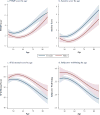The Demography of Mental Health Among Mature Adults in a Low-Income, High-HIV-Prevalence Context
- PMID: 28752487
- PMCID: PMC5640263
- DOI: 10.1007/s13524-017-0596-9
The Demography of Mental Health Among Mature Adults in a Low-Income, High-HIV-Prevalence Context
Abstract
Very few studies have investigated mental health in sub-Saharan Africa (SSA). Using data from Malawi, this article provides a first picture of the demography of depression and anxiety (DA) among mature adults (aged 45 or older) in a low-income country with high HIV prevalence. DA are more frequent among women than men, and individuals affected by one are often affected by the other. DA are associated with adverse outcomes, such as poorer nutrition intake and reduced work efforts. DA also increase substantially with age, and mature adults can expect to spend a substantial fraction of their remaining lifetime-for instance, 52 % for a 55-year-old woman-affected by DA. The positive age gradients of DA are not due to cohort effects, and they are in sharp contrast to the age pattern of mental health that has been shown in high-income contexts, where older individuals often experience lower levels of DA. Although socioeconomic and risk- or uncertainty-related stressors are strongly associated with DA, they do not explain the positive age gradients and gender gap in DA. Stressors related to physical health, however, do. Hence, our analyses suggest that the general decline of physical health with age is the key driver of the rise of DA with age in this low-income SSA context.
Keywords: Aging; Anxiety; Depression; Malawi; Mental health.
Figures



Similar articles
-
Cohort profile: the mature adults cohort of the Malawi longitudinal study of families and health (MLSFH-MAC).BMJ Open. 2020 Oct 16;10(10):e038232. doi: 10.1136/bmjopen-2020-038232. BMJ Open. 2020. PMID: 33067285 Free PMC article.
-
Disability transitions and health expectancies among adults 45 years and older in Malawi: a cohort-based model.PLoS Med. 2013;10(5):e1001435. doi: 10.1371/journal.pmed.1001435. Epub 2013 May 7. PLoS Med. 2013. PMID: 23667343 Free PMC article.
-
What explains gender inequalities in HIV/AIDS prevalence in sub-Saharan Africa? Evidence from the demographic and health surveys.BMC Public Health. 2016 Nov 3;16(1):1136. doi: 10.1186/s12889-016-3783-5. BMC Public Health. 2016. PMID: 27809824 Free PMC article.
-
["Mental Health in Adults with Intellectual Disabilities. Protective and Risk Factors for Depression and Anxiety" - a Cross-sectional Study].Gesundheitswesen. 2017 May;79(5):415-418. doi: 10.1055/s-0035-1564163. Epub 2015 Nov 9. Gesundheitswesen. 2017. PMID: 26551856 Review. German.
-
Nutrition, health, and aging in sub-Saharan Africa.Nutr Rev. 2008 Nov;66(11):611-23. doi: 10.1111/j.1753-4887.2008.00113.x. Nutr Rev. 2008. PMID: 19019023 Review.
Cited by
-
Cohort profile: the mature adults cohort of the Malawi longitudinal study of families and health (MLSFH-MAC).BMJ Open. 2020 Oct 16;10(10):e038232. doi: 10.1136/bmjopen-2020-038232. BMJ Open. 2020. PMID: 33067285 Free PMC article.
-
Predictors of mental health during the Covid-19 pandemic in the US: Role of economic concerns, health worries and social distancing.PLoS One. 2020 Nov 11;15(11):e0241895. doi: 10.1371/journal.pone.0241895. eCollection 2020. PLoS One. 2020. PMID: 33175894 Free PMC article.
-
Mental health and life-course shocks in a low-income country: Evidence from Malawi.SSM Popul Health. 2022 Apr 26;19:101098. doi: 10.1016/j.ssmph.2022.101098. eCollection 2022 Sep. SSM Popul Health. 2022. PMID: 35711726 Free PMC article.
-
Marital experiences and depressive symptoms among older adults in rural South Africa.SSM Ment Health. 2022 Dec;2:100083. doi: 10.1016/j.ssmmh.2022.100083. Epub 2022 Mar 2. SSM Ment Health. 2022. PMID: 36277994 Free PMC article.
-
The Psychological Benefits of Marriage and Children in Rural Malawi.Stud Fam Plann. 2020 Sep;51(3):251-272. doi: 10.1111/sifp.12133. Epub 2020 Jul 27. Stud Fam Plann. 2020. PMID: 32720321 Free PMC article.
References
-
- Arriaga EE. Measuring and explaining the change in life expectancies. Demography. 1984;21:83–96. - PubMed
-
- Baird S, de Hoop J, Özler B. Income shocks and adolescent mental health. Washington, DC: World Bank; 2011. (World Bank Policy Research Working Paper No. 5644). Retrieved from http://ideas.repec.org/p/wbk/wbrwps/5644.html.
-
- Bandawe CR. Gap analysis for the National Health Research Agenda of Malawi: Research priorities for the theme of mental health. Lilongwe, Malawi: National Commission for Science and Technology (NCST), Health Research Capacity Strengthening Initiative (HRCSI); 2010.
-
- Blanchflower DG, Oswald AJ. Is well-being U-shaped over the life cycle? Social Science & Medicine. 2008;66:1733–1749. - PubMed
Publication types
MeSH terms
Grants and funding
LinkOut - more resources
Full Text Sources
Other Literature Sources
Medical
Research Materials
Miscellaneous

